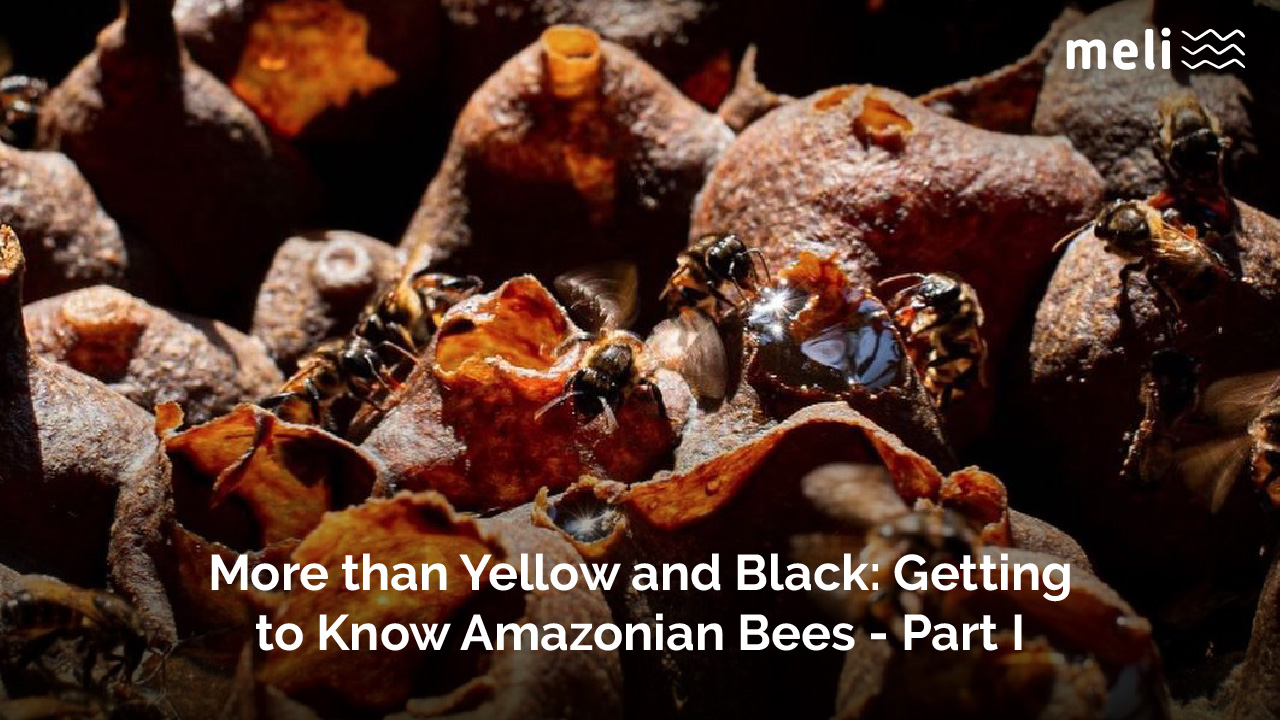Socially, environmentally and culturally important, bees offer important services for the areas they live in. But did you know they are also very diverse? Let’s learn more about bees from the Amazon!
Author: Guilherme Moreira
Leia em Português.
::
Bees stand out for their crucial role in the maintenance of biodiversity which they play due to their interaction with different plant species (Sá; Prato, 2007).
Most of these bee species are solitary, i.e. they do not form hives, while only about 15% are social bee species that live in colonies. Among the social species, about 400 of them are part of a group called Meliponines (that we honour in our name, Meli!) and have no functional sting — they are known as stingless bees.
Meliponines are spread throughout the tropical and subtropical regions of the earth. The Americas hold a prominent position in the diversity of these species, with approximately 350 described types, 250 of them in Brazil alone (Villas-Bôas, 2018). Within the group of Meliponines are different genera, such as Melipona and Trigona.
Melipona are large bees, often called “uruçú” (from the ancient Tupi “ira”, bee, + “açu”, big). The Trigona group of bees are small and brave. There are records of almost 200 species of stingless bees in the Brazilian Amazon and in the midst of all this biodiversity, there is still much to be studied: We still know little about the biology, behaviour, and reproduction of some species – and we know that others have not even been catalogued yet!
Let us start talking about four Amazonian bees from the Melipona group, which are kept in a more widespread manner. Besides their important environmental role, they and their products have economic, nutritional, therapeutic, and cultural reach in rural communities and even in urban centres.
::
Melipona fasciculata (Smith, 1854)
Known by the names Tiuba, Tiuba-do-Maranhão or Uruçú-Cinzenta, it is, without any doubt, one of the best known bees among meliponiculturists and are found in most of the Amazon region and surroundings: The states of Maranhão, Piauí, Pará, Tocantins, and Mato Grosso. In some cases the entrance of their hive forms a rather short tube, with protrusions ornamenting the edges. They are large bees, measuring about 12mm in length.
A selective bee according to popular wisdom, both in relation to the flowers it visits and in the choice of nesting sites, which makes it a sensitive and vulnerable bee to habitat degradation.
This bee serves the reproduction and maintenance of genetic diversity of native flora in forests and can assist in the recovery of degraded areas. It is an excellent honey producer, with records of productions of up to 10 liters/colony/year in the Baixada Maranhense region, where its keeping is more widespread.
::
Melipona flavolineata (Friese, 1900)
Called Uruçú-Amarela, this bee possesses a striking beauty; it is predominantly golden and large (9-10mm) and found in the states of Pará, Tocantins, and Maranhão. It is one of the most important species in the context of familiar m´Meliponiculture in Pará, standing out for its production of honey, which is highly appreciated. The entrance of its hive is formed by a prominent “pipe” of batume (geopropolis, a mix of mud and propolis), decorated with spikes and orifices.
Its colony is usually large and when the hive is strong, it is usually very aggressive. Although these bees have no stings, they have mandibles that are quite troublesome for predators or whoever handles them.
It is important to mention that there are several yellow colored Melipona, which is why several species of bees are called “Uruçú-Amarela”, such as: Melipona rufiventris, Melipona puncticolis, Melipona fulva, Melipona mondury, Melipona captiosa, Melipona cramptoni, Melipona dubia, Melipona paraensis, Melipona brachychaeta, etc. It is not easy to differentiate them, but we can also consider the place of occurrence, the architecture of the hive entrance, the morphology, the habits and, of course, genetics to do so.
This species is an excellent producer of honey, being able to produce an average of 3-6 liters/colony/year.
::
Melipona Seminigra Merrillae (Friese, 1903)
Known as “Uruçú-Boca-de-Renda” due to the shape of the entrance of its hive, this bee is one of the locals’ favourites. It occurs most frequently in Pará and Amazonas, although it has been found in other Amazonian states. The bees are medium-sized and robust, with a total length of around 11 mm.
Popular wisdom believes that this species has a generalist feeding habit, collecting various types of pollen, and they tend to concentrate their collections on plant species with massive flowering periods.
They experience an early growth, are populous (around 2,000 individuals per colony), and produce a good amount of honey, around 2-4 litres/colony/year. Although there are reports of production of up to 20 litres of honey per year, the production is almost double of that which is obtained by Apis mellifera scutellata hives in the same region (Kerr, 1967).
::
Melipona Seminigra Pernigra
Speaking of Melipona Seminigra, we cannot forget the subspecies Pernigra (see cover photo). Known as Uruçu-Boca-de-Renda Preta or Uruçu Preta, it also presents the characteristic entrance of its hive.
But among several similarities, these relatives differ in colour, habits, and places of occurrence. Melipona Seminigra Pernigra is found in transitional areas of the Amazon region, such as Maranhão, Tocantins, and parts of Pará.
It is also important to comment on the possibility of hybridization of the merrillae and mernigra when kept together; they interbreed, and totally black individuals and individuals with a totally yellow abdomen have been observed in the same hive (Camargo,1994).
Bees play an indispensable role within the ecosystem. Therefore, whether in the primary forest, rural, or even urban areas, Meliponiculture deserves to be studied and developed by society at large. Let’s strengthen the practice of Meliponiculture in Brazil, especially in the Amazon!
Your donation can have a positive impact on the world!
Subscribe to receive our Newsletter!
Find us also at Linkedin, Facebook, Twitter or Instagram
www.meli-bees.org
❤️


One Reply to “More than Yellow and Black: Getting to Know Amazonian Bees – Part I”